初中非谓语动词讲解
- 格式:ppt
- 大小:579.50 KB
- 文档页数:14

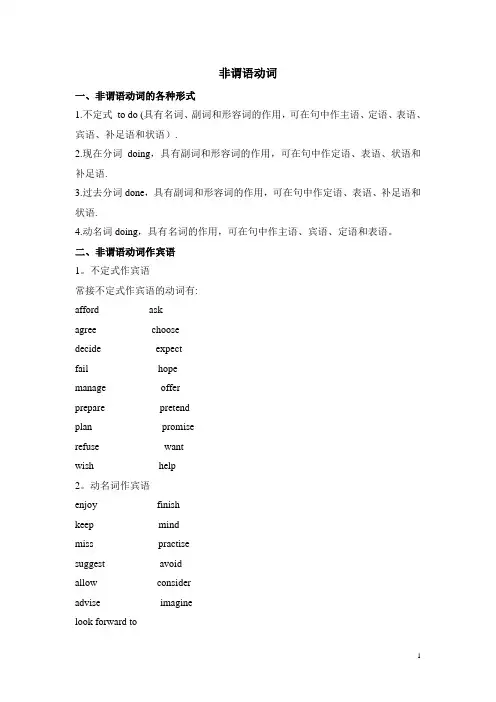
非谓语动词一、非谓语动词的各种形式1.不定式to do (具有名词、副词和形容词的作用,可在句中作主语、定语、表语、宾语、补足语和状语).2.现在分词doing,具有副词和形容词的作用,可在句中作定语、表语、状语和补足语.3.过去分词done,具有副词和形容词的作用,可在句中作定语、表语、补足语和状语.4.动名词doing,具有名词的作用,可在句中作主语、宾语、定语和表语。
二、非谓语动词作宾语1。
不定式作宾语常接不定式作宾语的动词有:afford askagree choosedecide expectfail hopemanage offerprepare pretendplan promiserefuse wantwish help2。
动名词作宾语enjoy finishkeep mindmiss practisesuggest avoidallow consideradvise imaginelook forward to3.不定式与动名词作宾语的区别1)remember doing sthremember to do sthI remembered____the lights when I left the room.(to turn off,turning off)Remember ____the lights when you leave the room。
(to turn off,turning off)2)forget doing sthforget to do sthI have forgotten ____the flowers.(to water,watering)I have forgotten ____my homework.(to do ;doing)3)try doing sthtry to do sthLet’s try____at the back door.(knocking ;to knock)We’ll try ___ our teaching methods.(to improv;improving)4)go on doing sthgo on to do sthGet the children to go on ____stories one by one。

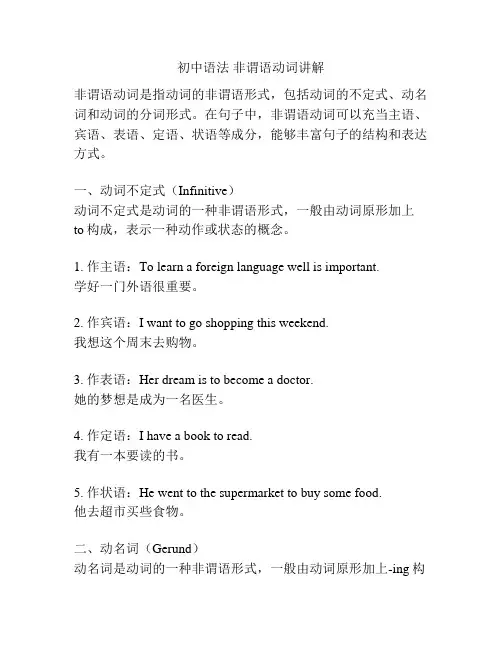
初中语法非谓语动词讲解非谓语动词是指动词的非谓语形式,包括动词的不定式、动名词和动词的分词形式。
在句子中,非谓语动词可以充当主语、宾语、表语、定语、状语等成分,能够丰富句子的结构和表达方式。
一、动词不定式(Infinitive)动词不定式是动词的一种非谓语形式,一般由动词原形加上to构成,表示一种动作或状态的概念。
1. 作主语:To learn a foreign language well is important.学好一门外语很重要。
2. 作宾语:I want to go shopping this weekend.我想这个周末去购物。
3. 作表语:Her dream is to become a doctor.她的梦想是成为一名医生。
4. 作定语:I have a book to read.我有一本要读的书。
5. 作状语:He went to the supermarket to buy some food.他去超市买些食物。
二、动名词(Gerund)动名词是动词的一种非谓语形式,一般由动词原形加上-ing构成,表示名词的概念。
1. 作主语:Swimming is a good exercise.游泳是一项好的锻炼。
2. 作宾语:I like playing basketball.我喜欢打篮球。
3. 作表语:His hobby is singing songs.他的爱好是唱歌。
4. 作定语:I saw a man reading a book.我看到一个人在读书。
5. 作状语:She came here by bike.她骑车来这里。
三、分词(Participle)分词是动词的一种非谓语形式,分为现在分词(-ing形式)和过去分词(-ed形式)。
1. 现在分词作定语:The running water is very refreshing in summer.夏天流动的水非常凉快。
2. 过去分词作定语:The broken window needs to be fixed.那个破窗户需要修理。
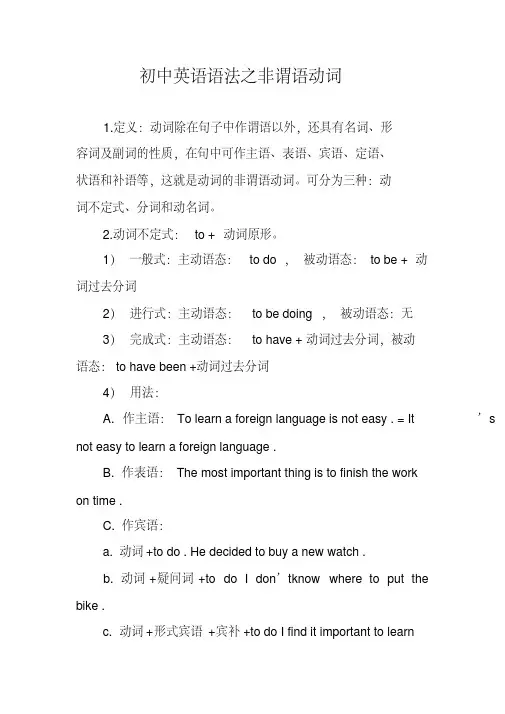
初中英语语法之非谓语动词1.定义:动词除在句子中作谓语以外,还具有名词、形容词及副词的性质,在句中可作主语、表语、宾语、定语、状语和补语等,这就是动词的非谓语动词。
可分为三种:动词不定式、分词和动名词。
2.动词不定式:to + 动词原形。
1)一般式:主动语态:to do ,被动语态:to be + 动词过去分词2)进行式:主动语态:to be doing ,被动语态:无3)完成式:主动语态:to have +动词过去分词,被动语态:to have been +动词过去分词4)用法:A. 作主语:To learn a foreign language is not easy . = It’s not easy to learn a foreign language .B. 作表语:The most important thing is to finish the workon time .C. 作宾语:a. 动词+to do . He decided to buy a new watch .b. 动词+疑问词+to do I don’t k now where to put thebike .c. 动词+形式宾语+宾补+to do I find it important to learna second foreign language .D. 作补语:a. 动词+宾语+to do Tom asked me to show him the new shoes .b. 动词+宾语+不带to的动词He often saw Tom play football .E. 作状语:a. 表示目的:He went to Guangzhou to see his sons . He got up early in order to catch the first bus .b. 表示结果:He is too tired to walk any farther . They aren’t old enough to go to school .c. 表示原因:He is sorry to hear that . I am glad to see you .F.作定语:I have something to tell you . I want to buy something to eat .5)动词不定式to 的省略:A. 在感官动词feel,hear,see,watch,notice 及使役动词have,let,make等后面要省to,但在变被动语态时要还原不定式to.I often saw him go out of the room .——He was often seen to go out of the room by me .B.在had better,would rather,do nothing but等后面常省to.6)动词不定式的否定形式:not + to do ,有时也可以用-never + to do 结构。

初中英语语法讲解——非谓语动词非谓语动词在句子中充当除谓语以外的句子成分的动词形式叫做非谓语动词。
非谓语动词分为三种形式:不定式,动名词,和分词(分词包括现在分词和过去分词)。
1)不定式a. 有些动词可以用动名词作宾语。
例如:2. worth 的用法worth, worthy, worthwhile都是形容词,意为"值得"。
1) worth:be worth + n.当名词为金钱时,表示"…… 值得……"常见的有It ’s worth while to do./ It ’s worth(someone’s)while doingbe worth doing sth."……某事值得被做"The question is not worth discussing again and again. 这问题不值得反复讨论。
2) worthy:be worthy of +n.当名词为抽象名词时表示"……值得……"be worthy to be done "某事值得被做"The question is not worthy to be discussed again and again.3) worthwhile:be worthwhile to do sth"值得做某事"It is worthwhile to ask him to join the club.值得邀请他加入俱乐部。
典型例题It is not ____ to discuss the question again and again.A. worthB. worthyC. worthwhileD. worth while答案C. 由worth的用法可知,此句只适合词组be worthwhile to do sth.。
选C。
动词不定式动词不定式由to+动词原形构成。
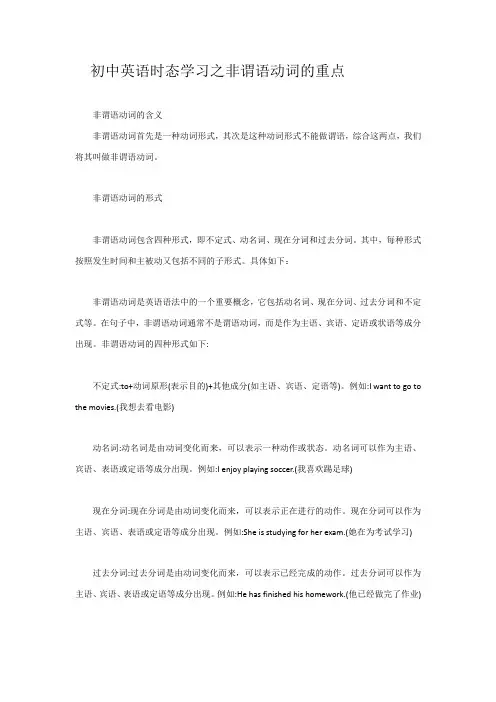
初中英语时态学习之非谓语动词的重点非谓语动词的含义非谓语动词首先是一种动词形式,其次是这种动词形式不能做谓语,综合这两点,我们将其叫做非谓语动词。
非谓语动词的形式非谓语动词包含四种形式,即不定式、动名词、现在分词和过去分词。
其中,每种形式按照发生时间和主被动又包括不同的子形式。
具体如下:非谓语动词是英语语法中的一个重要概念,它包括动名词、现在分词、过去分词和不定式等。
在句子中,非谓语动词通常不是谓语动词,而是作为主语、宾语、定语或状语等成分出现。
非谓语动词的四种形式如下:不定式:to+动词原形(表示目的)+其他成分(如主语、宾语、定语等)。
例如:I want to go to the movies.(我想去看电影)动名词:动名词是由动词变化而来,可以表示一种动作或状态。
动名词可以作为主语、宾语、表语或定语等成分出现。
例如:I enjoy playing soccer.(我喜欢踢足球)现在分词:现在分词是由动词变化而来,可以表示正在进行的动作。
现在分词可以作为主语、宾语、表语或定语等成分出现。
例如:She is studying for her exam.(她在为考试学习)过去分词:过去分词是由动词变化而来,可以表示已经完成的动作。
过去分词可以作为主语、宾语、表语或定语等成分出现。
例如:He has finished his homework.(他已经做完了作业)需要注意的是,每种形式的子形式也不同。
例如,不定式的完成时态为to have done,动名词的完成时态为had done,现在分词的完成时态为had been doing,过去分词的完成时态为had been done。
因此,在使用时需要根据具体情况选择相应的形式。
非谓语动词的语法非谓语动词除去不能做谓语之外,其它所有成分都可以做。
具体如下。
1. 不定式:做主语、宾语、表语、定语、状语和补语。
不定式是英语中的一种非谓语动词形式,它通常由to+动词原形构成。
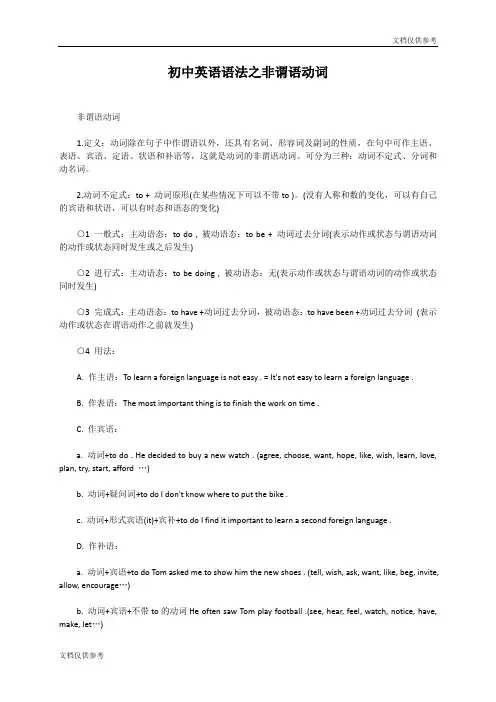
初中英语语法之非谓语动词非谓语动词1.定义:动词除在句子中作谓语以外,还具有名词、形容词及副词的性质,在句中可作主语、表语、宾语、定语、状语和补语等,这就是动词的非谓语动词。
可分为三种:动词不定式、分词和动名词。
2.动词不定式:to + 动词原形(在某些情况下可以不带to )。
(没有人称和数的变化,可以有自己的宾语和状语,可以有时态和语态的变化)○1 一般式:主动语态:to do , 被动语态:to be + 动词过去分词(表示动作或状态与谓语动词的动作或状态同时发生或之后发生)○2 进行式:主动语态:to be doing , 被动语态:无(表示动作或状态与谓语动词的动作或状态同时发生)○3 完成式:主动语态:to have +动词过去分词,被动语态:to have been +动词过去分词(表示动作或状态在谓语动作之前就发生)○4 用法:A. 作主语:To learn a foreign language is not easy . = It's not easy to learn a foreign language .B. 作表语:The most important thing is to finish the work on time .C. 作宾语:a. 动词+to do . He decided to buy a new watch . (agree, choose, want, hope, like, wish, learn, love, plan, try, start, afford …)b. 动词+疑问词+to do I don't know where to put the bike .c. 动词+形式宾语(it)+宾补+to do I find it important to learn a second foreign language .D. 作补语:a. 动词+宾语+to do Tom asked me to show him the new shoes . (tell, wish, ask, want, like, beg, invite, allow, encourage…)b. 动词+宾语+不带to的动词He often saw Tom play football .(see, hear, feel, watch, notice, have, make, let…)E. 作状语:a. 表示目的:He went to Guangzhou to see his sons . He got up early in order to catch the first bus .b. 表示结果:He is too tired to walk any farther . They aren't old enough to go to school .c. 表示原因:He is sorry to hear that . I am glad to see you .F.作定语:I have something to tell you . I want to buy something to eat .○5 动词不定式to 的省略:A. 在感官动词feel, hear, see, watch, notice 及使役动词have, let, make等后面要省to,但在变被动语态时要还原不定式to。
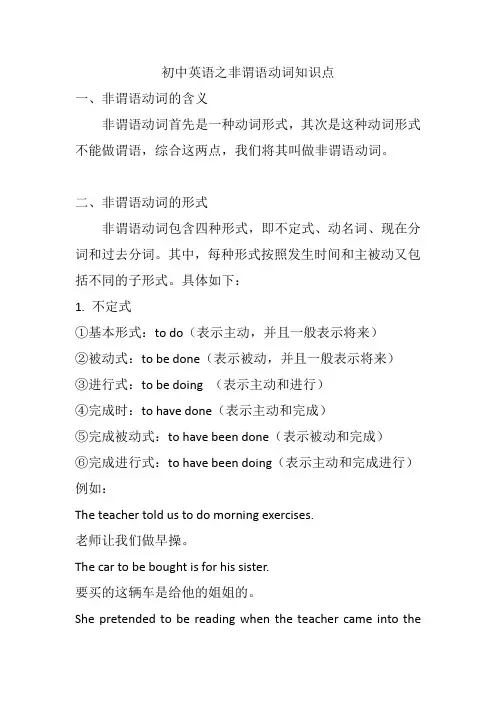
初中英语之非谓语动词知识点一、非谓语动词的含义非谓语动词首先是一种动词形式,其次是这种动词形式不能做谓语,综合这两点,我们将其叫做非谓语动词。
二、非谓语动词的形式非谓语动词包含四种形式,即不定式、动名词、现在分词和过去分词。
其中,每种形式按照发生时间和主被动又包括不同的子形式。
具体如下:1. 不定式①基本形式:to do(表示主动,并且一般表示将来)②被动式:to be done(表示被动,并且一般表示将来)③进行式:to be doing (表示主动和进行)④完成时:to have done(表示主动和完成)⑤完成被动式:to have been done(表示被动和完成)⑥完成进行式:to have been doing(表示主动和完成进行)例如:The teacher told us to do morning exercises.老师让我们做早操。
The car to be bought is for his sister.要买的这辆车是给他的姐姐的。
She pretended to be reading when the teacher came into theclassroom.老师进来时,她假装正在读书。
The thief is said to have escaped.据说小偷已经逃跑了。
The thief is said to have been arrested.据说小偷已经被抓住了。
She is said to have been working in the factory over the last 20 years.据说在过去的20年里,她一直在这家工厂工作。
2. 动名词①基本形式:doing(表示主动)②被动式:being done(表示被动)③完成式:having done(表示主动和完成)④完成被动式:having been done(表示被动和完成)例如:Travelling in space by ordinary people will be common in the future.在未来,普通人在太空旅行将会是普遍的事情。
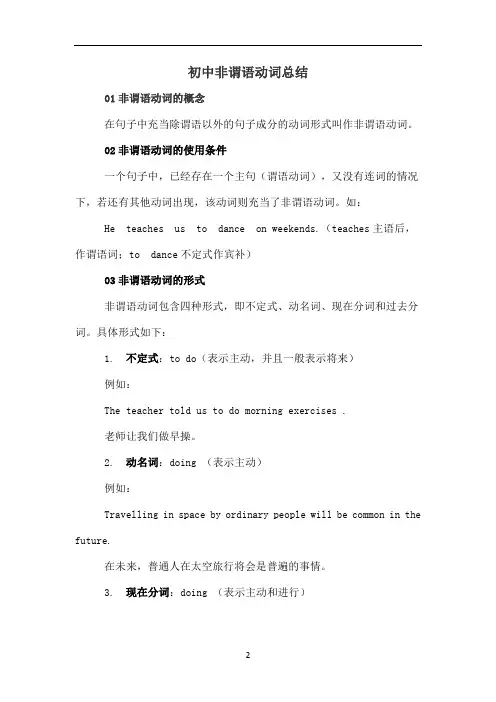
初中非谓语动词总结01非谓语动词的概念在句子中充当除谓语以外的句子成分的动词形式叫作非谓语动词。
02非谓语动词的使用条件一个句子中,已经存在一个主句(谓语动词),又没有连词的情况下,若还有其他动词出现,该动词则充当了非谓语动词。
如:He teaches us to dance on weekends.(teaches主语后,作谓语词;to dance不定式作宾补)03非谓语动词的形式非谓语动词包含四种形式,即不定式、动名词、现在分词和过去分词。
具体形式如下:1. 不定式:to do(表示主动,并且一般表示将来)例如:The teacher told us to do morning exercises .老师让我们做早操。
2. 动名词:doing (表示主动)例如:Travelling in space by ordinary people will be common in the future.在未来,普通人在太空旅行将会是普遍的事情。
3. 现在分词:doing (表示主动和进行)例如:He sat there,reading a newspaper.他坐在那里,读着一张报纸。
4. 过去分词:done及物动词的过去分词表示被动或完成;不及物动词的过去分词表示主动或完成。
polluted river 被污染的河流(及物动词pollute和river之间是被动关系,即“河流被污染”)fallen leaves 落叶(不及物动词fall和leaves之间是主动关系,即“叶子落下来”)注意:非谓语动词本身不能表示现在和过去。
非谓语动词表示进行和将来是相对于谓语动作来说的:和谓语动作同时发生表示进行;发生在谓语动作之后表示将来04非谓语动词的作用非谓语动词除去不能做谓语之外,其它所有成分都可以做。
具体如下。
动词不定式一、特点:1. 没有人称和数的变化2. 可以有自己的宾语和状语3. 有时态和语态的变化(被动语态形式为to be+动词的过去分词)二、句法作用:做主语、宾语、表语、定语、状语和补语。
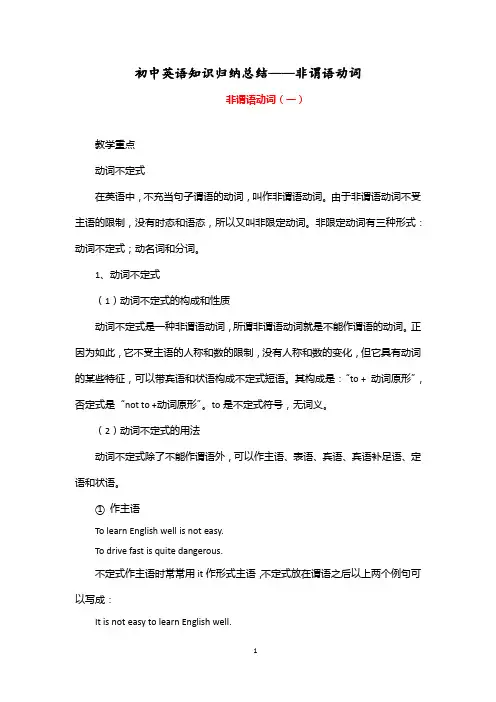
初中英语知识归纳总结——非谓语动词非谓语动词(一)教学重点动词不定式在英语中,不充当句子谓语的动词,叫作非谓语动词。
由于非谓语动词不受主语的限制,没有时态和语态,所以又叫非限定动词。
非限定动词有三种形式:动词不定式;动名词和分词。
1、动词不定式(1)动词不定式的构成和性质动词不定式是一种非谓语动词,所谓非谓语动词就是不能作谓语的动词。
正因为如此,它不受主语的人称和数的限制,没有人称和数的变化,但它具有动词的某些特征,可以带宾语和状语构成不定式短语。
其构成是:“to + 动词原形”,否定式是“not to +动词原形”。
to是不定式符号,无词义。
(2)动词不定式的用法动词不定式除了不能作谓语外,可以作主语、表语、宾语、宾语补足语、定语和状语。
①作主语To learn English well is not easy.To drive fast is quite dangerous.不定式作主语时常常用it作形式主语,不定式放在谓语之后以上两个例句可以写成:It is not easy to learn English well.It is quite dangerous to drive fast.这种用法可以归纳成这样一个句型:It is (not) + 形容词+ (for sb.) to do sth.It is very expensive for me to buy a car.It is very difficult for a child to do that job.有些形容词之后跟of + 名词(代词宾语)+不定式。
如:It is very kind of you to say so.It is very good of you to come.②作表语。
如:My job is to teach English.The first thing is to ring him up.③作宾语。
初中英语语法非谓语动词知识点讲解及专项练习一非谓语动词的概念在句子中充当除谓语以外的句子成分的动词形式叫做非谓语动词它不受人称和数的限制非谓语动词分为三种形式:不定式:to+动词原形动名词:动词原形+ing分词(现在分词和过去分词)二、动名词的用法动名词是由动词原形+ ing 构成,形式同现在分词形式一样,其否定形式是not + 动词原形+ ing。
1、动名词作主语:Talking like that is not polite. 那样谈话不礼貌。
Learning from others is important. 向别人学习很重要。
Putting on more clothes is not so good . 多穿衣服不一定好。
动名词作主语通常用一般式,可以像动词不定式一样,用it 先行词代替,而把动名词写在后面。
It's no use waiting here, let's go home. 在这儿等着也没用,我们回家吧。
It's very difficult climbing this mountain. 爬这座山很困难。
2、动名词作表语The nurse's job is looking after the patients. 护士的工作是护理病人。
Seeing is believing. 眼见为实。
3、动名词作定语She is studying in the reading room. 她在阅览室学习。
He slept in the sleeping bag. 他在睡袋里睡觉。
4、动名词作宾语Please stop smoking in the house. 请不要在家里抽烟。
I like reading in the forest. 我喜欢在树林里读书。
Do you mind my opening the windows? 你介意我打开窗户吗?She is found of collecting stamp. 她喜欢集邮。
初中英语非谓语动词讲解非谓语动词是指动词在句子中不作谓语,而作其他成分或者补充说明的形式。
在英语中,非谓语动词包括动词不定式、动名词和分词。
下面将分别对这三种非谓语动词进行详细解释。
一、动词不定式(infinitive)动词不定式是以to作为标志的动词形式,通常有两种形式:一种是带有to的形式,称为带to的不定式;另一种是省略to 的形式,称为不带to的不定式。
带to的不定式的用法包括:1. 作为动词的宾语,如:She agreed to help me.2. 作为动词的补语,如:I want to be a teacher.3. 用于某些固定的动词后面,如:She promised to come early.4. 用于某些形容词后面,如:I am happy to see you.不带to的不定式的用法包括:1. 作为句子的主语,如:To learn a foreign language is important.2. 作为动词的宾语,如:She made him clean the room.3. 作为某些动词后的宾补,如:We saw him leave the house.动词不定式还有时态和语态的变化,例如:一般式:to do完成式:to have done被动式:to be done二、动名词(gerund)动名词是动词加上-ing形式构成的名词,它既具有动词的特点,又具有名词的特点。
动名词的用法包括:1. 作为动词的主语,如:Swimming is good exercise.2. 作为动词的宾语,如:I enjoy swimming in the summer.3. 作为介词的宾语,如:She is good at playing the piano.动名词也可以带有物主代词、名词性物主代词或名词作定语,如:I appreciate your helping me.三、分词(participle)分词是由动词的-ing或-ed形式构成的,它可以用作动词的形容词化形式,表示被动意义或者作为形容词修饰名词。
初中知识点归纳非谓语动词的分类与形式非谓语动词是指在句子中作状语、定语或补语,不具备时态和人称的动词形式。
初中阶段涉及的非谓语动词主要包括动词不定式、动名词和分词。
本文将对非谓语动词的分类与形式进行归纳。
一、动词不定式(infinitive)动词不定式是非谓语动词中最常见的形式之一,它由“to + 动词原形”构成,具有名词和动词的双重性质。
1. 主动形式主动形式的动词不定式可以作为句子的主语、宾语、表语、宾语补足语等。
例如:- To learn English well is my goal. (主语)- He likes to play football. (宾语)- Her dream is to become a doctor. (表语)- They want to buy a new car. (宾语补足语)2. 被动形式被动形式的动词不定式表示动作的承受者,常用于被动语态中。
它由“to be + 过去分词”构成。
例如:- The job needs to be done quickly. (承受者为the job)- He hopes to be invited to the party. (承受者为he)3. 否定形式否定形式的动词不定式在“to”之后添加“not”,表示否定的意义。
例如:- I decided not to go to the party. (否定形式作为不定式的一部分)二、动名词(gerund)动名词是以动词ing形式充当名词的一种形式,具有名词的特点,可以作为主语、宾语、表语、定语、宾语补足语等。
1. 作主语动名词作为句子的主语时,常用单数形式。
例如:- Reading is my favorite hobby.- Swimming is good for health.2. 作宾语动名词作为某些动词的宾语,表示动作的客体。
例如:- I enjoy playing basketball.- He avoids eating junk food.3. 作表语动名词作为表语时,通常表示状态或特征。
初中英语非谓语动词讲解在初中英语的学习中,非谓语动词是一个比较重要且有一定难度的语法点。
理解和掌握非谓语动词对于提高英语语言的运用能力有着至关重要的作用。
那么,什么是非谓语动词呢?非谓语动词就是在句子中不能单独作谓语的动词形式,主要包括动词不定式、动名词和分词(现在分词和过去分词)。
我们先来看看动词不定式。
动词不定式的基本形式是“to +动词原形”,比如“to study”“to play”。
它在句子中可以作主语、宾语、定语、状语、宾语补足语等成分。
作主语时,通常把动词不定式放在句首,谓语动词用单数形式。
例如:“To learn English well is not easy”(学好英语不容易。
)不过,为了避免句子头重脚轻,常用 it 作形式主语,真正的主语动词不定式后置,比如:“It is not easy to learn English well”作宾语的情况也很常见,比如“want to do sth”(想要做某事)“decide to do sth”(决定做某事)。
作定语时,动词不定式通常放在被修饰的名词或代词后面,例如:“I have a lot of homework to do”(我有很多作业要做。
)作状语时,可以表示目的、结果等。
比如“He came here to see me”(他来这儿是为了看我。
)“He is too young to go to school”(他太小了,不能上学。
)作宾语补足语的例子有“ask sb to do sth”(让某人做某事)“tell sb to do sth”(告诉某人做某事)。
接下来是动名词。
动名词是由动词+ ing 形式构成,比如“studying”“playing”。
动名词具有名词的特征,在句中可以作主语、宾语、定语等。
作主语时,谓语动词用单数形式,例如:“Swimming is good for health”(游泳对健康有益。
初中英语语法-⾮谓语动词⾮谓语动词⼀.定义:⾮谓语动词是指在句⼦中不是谓语的动词,即动词的⾮谓语形式。
约占中考10%。
⼆.分类:动词不定式、v-ing形式和过去分词。
1.动词不定式1)构成:(not) to do / (not) do2)句法功能:(1)作主语:To finish the work in ten minutes is very hard. ⼗分钟之内完成这项⼯作是很难的。
To lose your heart means failure. 灰⼼意味着失败。
动词不定式短语作主语时,常⽤it作形式主语,真正的主语不定式置于句后,例如上⾯两句可⽤如下形式:It is very hard to finish the work in ten minutes. ⼗分钟之内完成这项⼯作是很难的。
It means failure to lose your heart. 灰⼼意味着失败。
常⽤句式:It+be+名词+to do sth.It takes sb.+some time+to do sth.It+be+形容词+of /forsb +to do sth.常⽤careless, clever, good, foolish, honest, kind, lazy, nice, right, silly, stupid, wise,等表⽰赞扬或批评的形容词,不定式前的sb.可作其逻辑主语。
区别:当使⽤for时,句中形容词修饰的是不定式;It’s necessary for you to study hard .(necessary 修饰to study hard,表⽰学习努⼒是有必要的)⽽⽤of时,句中形容词修饰逻辑主语。
It’s fo olish of him to do it .(foolish 修饰逻辑主语him)(2)作表语:Her job is to clean the hall. 她的⼯作是打扫⼤厅。